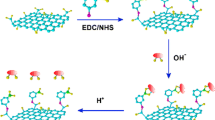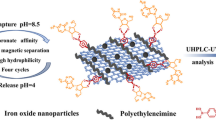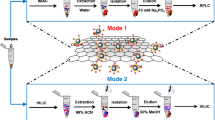Abstract
A hybrid material was prepared from graphene oxide and melamine sponge, and modified with phenylboronic acid to obtain a sorbent for the enrichment of the nucleosides cytidine, uridine, inosine, guanosine and adenosine. The loading capacity typically is around 27.8 mg g−1 which is comparable to other sorbents, and highly selectivity for cis-diols is observed even if the concentration of potential interferents is 1500-fold higher. The sorbent was placed in an injector, and the process was operated semiautomatically by using a peristaltic pump. The sorbent is stable and can be re-used six times without decrease in efficiency. It was applied to the selective extraction of the cis-diols (cytidine, uridine, inosine, guanosine, adenosine) from HepG2 cells. It presents good linear between 3 to 5000 μg L−1 and the limits of detection (in HPLC analysis with UV detection) are 1–4 μg L−1. Good recoveries of 85–101% were obtained with spiked HepG2 cells samples, with relative standard deviation of ≤9.9%.

Schematic for the preparation of boronic acid modified graphene oxide/melamine sponge composite for in-syringe solid-phase extraction of nucleosides.




Similar content being viewed by others
References
Ren L, Liu Y, Dong M, Liu Z (2009) Synthesis of hydrophilic boronate affinity monolithic capillary for specific capture of glycoproteins by capillary liquid chromatography. J Chromatogr A 1216:8421–8425
Yang J, He X, Chen L, ZhangY (2017) Thiol-yne click synthesis of boronic acid functionalized silica nanoparticle-graphene oxide composites for highly selective enrichment of glycoproteins. J Chromatogr A 1513:118–125
Wu Q, Jiang B, Weng Y, Liu J, Li S, Hu Y, Yang K, Liang Z, Zhang L, Zhang Y (2018) 3-Carboxybenzoboroxole functionalized polyethylenimine modified magnetic graphene oxide nanocomposites for human plasma glycoproteins enrichment under physiological condition. Anal Chem 90:2671–2677
Su J, He X, Chen L, Zhang Y (2018) A combination of "thiol-ene" click chemistry and surface initiated atom transfer radical polymerization: fabrication of boronic acid functionalized magnetic graphene oxide composite for enrichment of glycoproteins. Talanta 180:54–60
Okutucu B, Önal S (2011) Molecularly imprinted polymers for separation of various sugars from humanurine. Talanta 87:74–79
Huang W, Yang X, Zhao S, Zhang M, Hu X, Wang J, Zhao H (2013) Fast and selective recognizes polysaccharide by surfacemolecularly imprinted film coated onto aldehyde-modified magnetic nanoparticles. Analyst 138:6653–6661
Wang C, Xu H, Wei Y (2016) The preparation of high-capacity boronate affinity adsorbents by surface initiated reversible addition fragmentation chain transfer polymerization for the enrichment of ribonucleosides in serum. Anal Chim Acta 902:115–122
Li H, Zhang X, Zhang L, Wang X, Kong F, Fan D, Li L, Wang W (2016) Preparation of a boronate affinity silica stationary phase with enhanced binding properties towards cis-diol compounds. J Chromatogr A 1473:90–98
Li H, Zhu S, Cheng T, Wang S, Zhu B, Liu X, Zhang H (2016) Binary boronic acid-functionalized attapulgite with high adsorption capacity for selective capture of nucleosides at acidic pH values. Microchim Acta 183:1779–1786
Pham VH, Dickerson JH (2014) Superhydrophobic silanized melamine sponges as high efficiency oil absorbent materials. ACS Appl Mater Interfaces 6:14181–14188
Lei Z, Deng Y, Wang C (2016) Ambient-temperature fabrication of melamine-based sponges coated with hydrophobic lignin shells by surface dip adsorbing for oil/water separation. RSC Adv 6:106928–106934
Liu Q, Meng K, Ding K, Wang Y (2015) A superhydrophobic sponge with hierarchical structure as an efficient and recyclable oil absorbent. Chem Plus Chem 80:1435–1439
Yang Y, Yi H, Wang C (2015) Oil absorbents based on melamine/lignin by a dip adsorbing method. ACS Sustain Chem Eng 3:3012–3018
Liu S, Pan J, Ma Y, Qiu F, Niu X, Zhang T, Yang L (2016) Three-in-one strategy for selective adsorption and effective separation of cis-diol containing luteolin from peanut shell coarse extract using PU/GO/BA-MOF composite. Chem Eng J 306:655–666
Zhou M, Xie J, Yan S, Jiang X, Ye T, Wu W (2014) Graphene@poly(phenylboronic acid)s microgels with selectively glucose-responsive volume phase transition behavior at a physiological pH. Macromolecules 47:6055–6066
Liu T, Zhao G, Zhang W, Chi H, Hou C, Sun Y (2015) The preparation of superhydrophobic graphene/melamine composite sponge applied in treatment of oil pollution. J Porous Mater 22:1573–1580
Ma J, Wang C, Wei Y (2016) Polyethyleneimine-facilitated high-capacity boronate affinity membrane and its application for the adsorption and enrichment of cis-diol-containing molecules. RSC Adv 6:43648–43655
Wang ST, Chen D, Ding J, Yuan BF, Feng YQ (2013) Borated titania, a new option for the selective enrichment of cis-diol biomolecules. Chem-Eur J 19:606–612
Yang F, Mao J, He XW, Chen LX, Zhang YK (2013) Preparation of a boronate-functionalized affinity hybrid monolith for specific capture of glycoproteins. Anal Bioanal Chem 405:5321–5331
Cheng T, Li H, Ma Y, Liu X, Zhang H (2015) Synthesis of boronic-acid-functionalized magnetic attapulgite for selective enrichment of nucleosides. Anal Bioanal Chem 407:3525–3529
Li D, Li Y, Li X, Bie Z, Pan X, Zhang Q, Liu Z (2015) A high boronate avidity monolithic capillary for the selective enrichment of trace glycoproteins. J Chromatogr A 1384:88–96
Ding J, Mao LJ, Guo N, Yu L, Feng YQ (2016) Determination of endogenous brassinosteroids using sequential magnetic solid phase extraction followed by in situ derivatization/desorption method coupled with liquid chromatography-tandem mass spectrometry. J Chromatogr A 1446:103–113
Gao L, Wang C, Wei Y (2016) Enhanced binding capacity of boronate affinity fibrous material for effective enrichment of nucleosides in urine samples. RSC Adv 6:28470–28476
Li H, Cheng T, Wang S, Zhu X, Zhang H (2016) High-efficiency extraction of nucleosides based on the combination of self-assembly ionic liquid layer and boronic acid-functionalized attapulgite. Talanta 153:71–78
Yang Y, Nan J, Hou J, Yu B, Zhao T, Xu S, Lv S, Zhang H (2014) Cytotoxicity of gold nanoclusters in human liver cancer cells. Int J Nanomedicine 9:5441–5448
Acknowledgments
This work was financially supported by the National Natural Science Foundation of China (Nos. 21375052 and 21575055).
Author information
Authors and Affiliations
Corresponding author
Ethics declarations
The author(s) declare that they have no competing interests.
Electronic supplementary material
ESM 1
(DOCX 1590 kb)
Rights and permissions
About this article
Cite this article
Cheng, T., Jiao, Z., Liu, X. et al. Selective, fast and semi-automatic enrichment of nucleosides by using a phenylboronic acid modified hybrid material composed of graphene oxide and melamine sponge. Microchim Acta 185, 348 (2018). https://doi.org/10.1007/s00604-018-2878-3
Received:
Accepted:
Published:
DOI: https://doi.org/10.1007/s00604-018-2878-3




